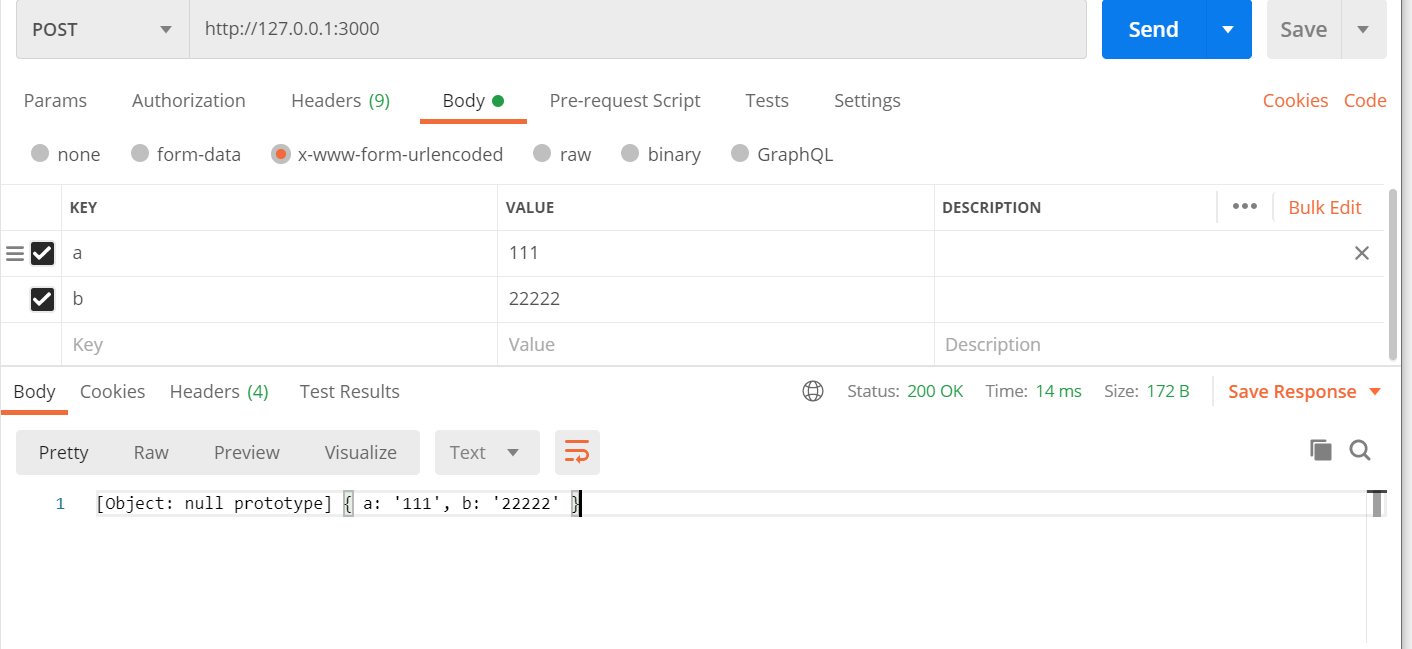nodejs学习(四)GET/POST请求
一.获取GET请求内容
由于GET请求直接被嵌入在路径中,URL是完整的请求路径,包括了?后面的部分,因此你可以手动解析后面的内容作为GET请求的参数。
node.js 中 url 模块中的 parse 函数提供了这个功能。
1 2 3 4 5 6 7 8 | var http = require('http');var url = require('url');var util = require('util'); http.createServer(function(req, res){ res.writeHead(200, {'Content-Type': 'text/plain; charset=utf-8'}); res.end(util.inspect(url.parse(req.url, true)));}).listen(3000); |
在浏览器中访问 http://127.0.0.1:8888/index?a=b&c=d然后查看返回结果:
Url { protocol: null, slashes: null, auth: null, host: null, port: null, hostname: null, hash: null, search: '?a=b&c=d', query: [Object: null prototype] { a: 'b', c: 'd' }, pathname: '/index', path: '/index?a=b&c=d', href: '/index?a=b&c=d' }
二.获取 URL 的参数
我们可以使用 url.parse 方法来解析 URL 中的参数,代码如下:
1 2 3 4 5 6 7 8 9 10 11 12 13 14 15 16 17 18 | //var http = require('http');var url = require('url');var util = require('util');http.createServer(function(req, res){ res.writeHead(200, {'Content-Type': 'text/plain;;charset=utf-8'}); // 解析 url 参数 var params = url.parse(req.url, true).query; res.write("网站名:" + params.name); res.write("\n"); res.write("网站 URL:" + params.url); res.end();}).listen(8888); |
在浏览器中访问 http://127.0.0.1:8888/index?name=tom&url=madou.com然后查看返回结果:
1 2 | 网站名:tom网站 URL:madou.com |
二.获取 POST 请求内容
POST 请求的内容全部的都在请求体中,http.ServerRequest 并没有一个属性内容为请求体,原因是等待请求体传输可能是一件耗时的工作。
比如上传文件,而很多时候我们可能并不需要理会请求体的内容,恶意的POST请求会大大消耗服务器的资源,所以 node.js 默认是不会解析请求体的,当你需要的时候,需要手动来做。
1 2 3 4 5 6 7 8 9 10 11 12 13 14 15 16 17 18 19 | var http = require('http');var querystring = require('querystring');var util = require('util');http.createServer(function(req, res){ // 定义了一个post变量,用于暂存请求体的信息 var post = ''; // 通过req的data事件监听函数,每当接受到请求体的数据,就累加到post变量中 req.on('data', function(chunk){ post += chunk; }); // 在end事件触发后,通过querystring.parse将post解析为真正的POST请求格式,然后向客户端返回。 req.on('end', function(){ post = querystring.parse(post); res.end(util.inspect(post)); });}).listen(3000); |

三.解析url
1 2 3 4 5 6 7 8 9 10 11 12 13 14 15 16 17 18 19 20 21 22 23 24 25 | var url = require("url");var querystring = require("querystring");string = "http://localhost:8888/start?foo=bar&hello=world";//使用url模块console.log("使用url模块。。。。")console.log("query:" + " " + url.parse(string).query)console.log("path:" + " " + url.parse(string).path)console.log("pathname:" + " " + url.parse(string).pathname)//使用querystring模块console.log("使用querystring模块。。。。。。")console.log(querystring.parse(string))//使用全局变量URLconsole.log("URL模块。。。。。。。。。。。。。。。。")var myUrl = new URL(string);console.log(myUrl)console.log("myUrl_pathName:" + " " + myUrl.pathname)console.log("foo:" + " " + myUrl.searchParams.get("foo"))console.log("hello:" + " " + myUrl.searchParams.get("hello")) |




【推荐】国内首个AI IDE,深度理解中文开发场景,立即下载体验Trae
【推荐】编程新体验,更懂你的AI,立即体验豆包MarsCode编程助手
【推荐】抖音旗下AI助手豆包,你的智能百科全书,全免费不限次数
【推荐】轻量又高性能的 SSH 工具 IShell:AI 加持,快人一步
· 分享一个免费、快速、无限量使用的满血 DeepSeek R1 模型,支持深度思考和联网搜索!
· 25岁的心里话
· 基于 Docker 搭建 FRP 内网穿透开源项目(很简单哒)
· ollama系列01:轻松3步本地部署deepseek,普通电脑可用
· 闲置电脑爆改个人服务器(超详细) #公网映射 #Vmware虚拟网络编辑器
2019-03-26 关于字体反爬的思路(猫眼电影)
2019-03-26 路飞学城搭建值前后端结合